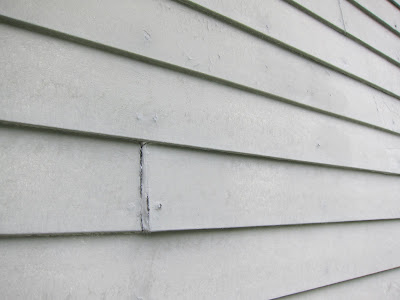Before gathering painting materials or buying paint, you should walk around your house and give it a good once-over. Look for loose and peeling paint, cracks, holes, broken siding, mildew, etc. It's a good idea to get a handle on what you're going to face before starting work. With this series of articles, I am going to show you some different problems you will probably encounter on your own house (I'll use some of our paint jobs to demonstrate).

Today we started preparing a new house up in Missoula's Rattlesnake neighborhood. This place hasn't been painted in about 10 years, and unfortunately, the last painters thinned the paint out with water so far that they didn't really apply a coat of paint. It has siding with wooden windows and trim. It also has 2 decks, which we'll look at later. The siding isn't wood--it's Masonite, which is basically pressed/glued sawdust. If you keep it sealed, it will last a long time. When it gets exposed to moisture, it tends to swell up a bit, puckering up around screw holes, or on the bottoms of siding boards.
 |
| This siding is close to the ground and may have been hit with a mower. |
 |
| A puckered nail hole where moisture got to the siding. Also note the thin coat of paint. |
You can see how splotchy the surface looks. This is also the southwestern side of the house and gets blasted most of the day with sun. And as you can see, the soffitt is tiny, so the siding gets wet every time it rains.
Since they applied such a non-coat, the film couldn't hold up against the weather. See the streaks of discoloration that ran down from the window? We are going to protect the siding so it hold up better this time.
The old paint is chalky and cracked in places. Most of the butt joints in the siding actually held up just fine, but there are some like this one. We'll remove the loose caulking, prime the siding, re-caulk the crack with Big Stretch, then paint it. Some paint manufacturers recommend priming both before and after caulking, but since Benjamin Moore's Aura is self-priming, we dont prime the caulking a second time. In fact, I'd be surprised to find very many people actually priming before applying caulking, let alone anybody doing it after.
With this house, the painting process is simple:
1. Scrape/sand all loose/peeling paint/caulking/filler.
2. Prime all bare wood and broken down old paint
3. Caulk all cracks, fill all holes
4. Prime all wood filler
5. Paint
Check out the next article in this series, How to Paint Your House: Scraping
Check out our website at VideoPaintGuide.com





No comments:
Post a Comment